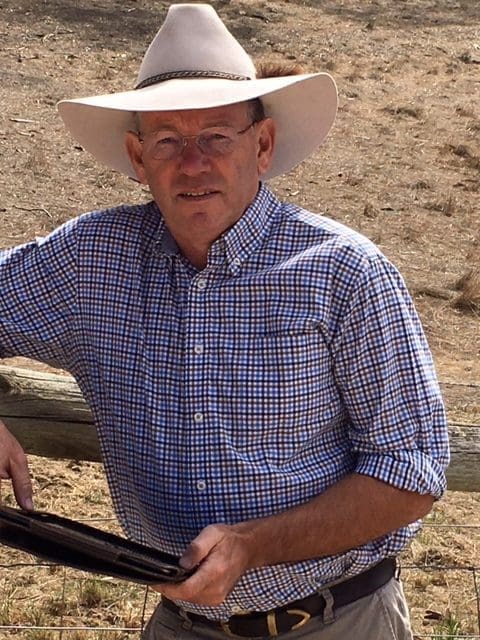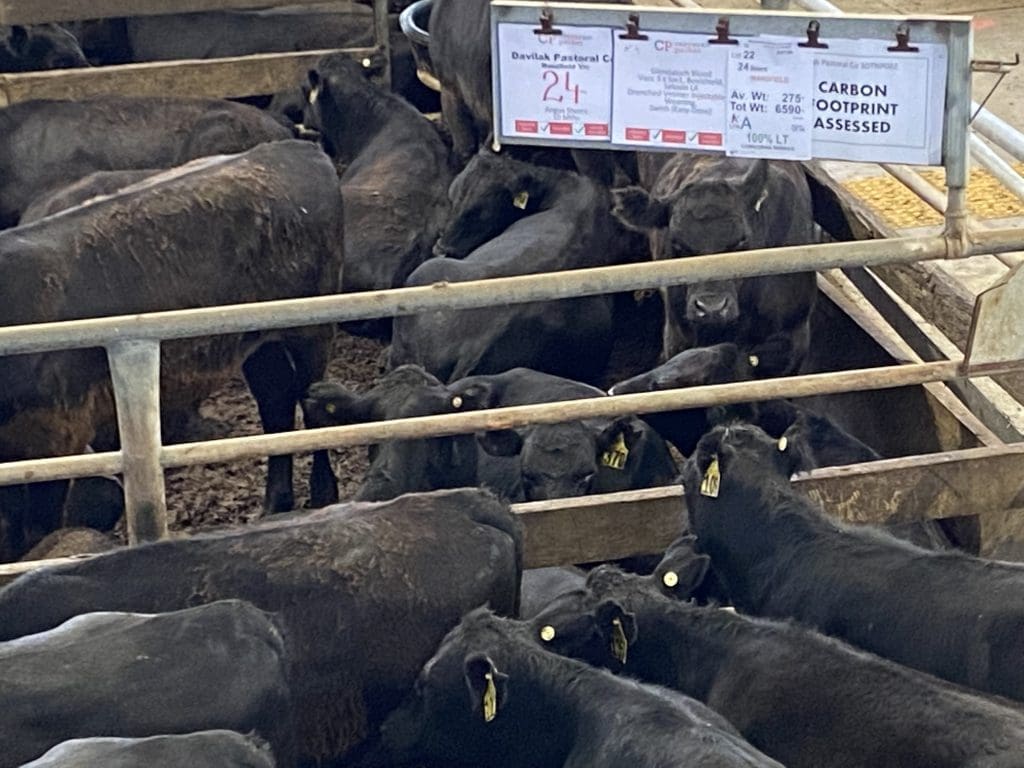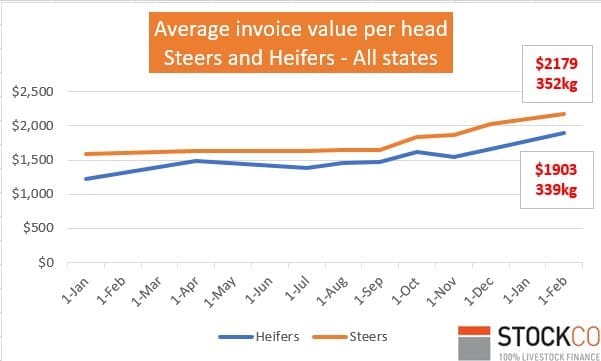 Chris Howie offers his perspective on market trends and opportunities in coming weeks and months, drawing from his own observations and from a wide contact network of producers, agents, processors, industry associates and leaders developed during his extensive career as a livestock agent. Chris is Stockco’s Business Development Manager.
Chris Howie offers his perspective on market trends and opportunities in coming weeks and months, drawing from his own observations and from a wide contact network of producers, agents, processors, industry associates and leaders developed during his extensive career as a livestock agent. Chris is Stockco’s Business Development Manager.
Performance data
I took the time to help weigh 350 calves with a client before Xmas. The question asked from one of his staff, “what’s the point of weighing commercial calves/lambs at marking?”
Simple answer, the operation now has base line information that will allow the measurement of sire performance, pasture performance, livestock rotation management and a trend line that helps measure an operation year on year. So simple, as the electronic tag becomes a management system adding benefit to the enterprise all the way to slaughter. Imagine in 2 years’ time these cattle can be cross referenced against the kill sheet showing what lines provided the best results. Just as easy with sheep at lamb marking time.
Add a paddock weighing systems and your operation can really fine tune performance. As Rob Inglis from Elders Livestock Production says “supplementary feeding livestock to maintain weight gain costs a lot less than feeding to recover lost condition”. With the recent federal funding announced for Ag I expect a renewed push on EID for sheep from various state governments. Instead of fighting the traceability for bio security utilize technology to help your sheep productivity.
Auctioneering
The standard of the agency sale teams at weaners sales was very good across all venues. Tips: A few younger auctioneers trying to go too fast and losing clarity and diction made understanding the bid difficult. Also nominating the buyer and final price is very important on a fast moving day. Getting opening calls right is critical as it is very easy to back a sale off if continually calling under the going rate. The art of reading the market is the difference between a good and poor performance on a hard day. Of all the sale centres I attended the highlight was the Wangaratta sale with Justin Keen, Corcoran and Parker and Brett Shea , Elders stacking the bids from a gallery of enthusiastic buyers – enthusiasm, energy and urgency, as my mentor and A grade sheep auctioneer, the late Gary Nowlan use to say.
Saleyards
A lot of rain fell early January which put the infrastructure of some sale yards under pressure and saw a rise in feet issues and pink eye by the time cattle got home. Avoidance of water pooling in outside pens of covered facilities needs drainage and doming pens, not scooping them out when cleaning.. Undercover and soft flooring is a huge benefit for trucking cattle but if incorrect flooring is put in or allowed to become powdery and dusty health issues for the cattle and the agents in the yards increase. The dust issue is a talking point at many undercover yards as I travel around and probably needs more focus on a solution not putting heads in the sand..
Cattle
Weaning: Notable over the last couple of years at the annual weaner sales is the slip away from properly weaning calves. A lot more “bellow” in the yards at some locations. In 2001 weaning sale calves was rare. Yet over the next 15 years more breeders went down the path and started to reap the backgrounder and feedlot rewards. I suppose the current market drives a not to wean mentality, “I am getting good money and not weaning them.” I haven’t done the calculation but if it is $50 or a $100 less for unweaned this year what does that look like if we have a dry season? My suggestion is continuing weaning– but do it properly and avoid weight loss.
Weaner sales: No market reports other than most calves were between 315 and 410kg. To buy any numbers you consistently needed $2200 – $2500 steers and $1800 – $2300 heifers. Prices settled as the sale series went on with the majority of the competition coming from NSW and Southern Queensland. The separation of price between Angus and coloured cattle did start to show towards the later sales as orders filled. EU cattle prices ebbed and flowed but overall there is a definite benefit as a breeder in having an EU ticket on the pen. We all take a breath for a week and the next series will start with Tasmania and the Mountains sales joining in as we head north.
Carbon
It was a first for me to see a placard with “Carbon Footprint Assessed” on the Davilak Pastoral Co pens in the Corcoran and Parker run of the Wangaratta weaner sale. I followed up Rodda Manning from Davilak to find out what the placard meant.

In a nutshell Rodda has created a base line carbon assessment within the Davilak business in preparation for the future. Using consultants Integrity Ag and Environment Rodda has been able to gain a starting point of CO2 per kg of beef produced. Hopkins River and Killara feedlots were keen competitors with the MacConachie family, as repeat buyers, securing a large number of the weaned angus calves.
Beef Central will run a standalone article in the future but I thought it worthwhile showing some of the innovation and next generation livestock production that helps the primary production story into the future.
Southern bull sales are here
What a great year to take a drive to look at the selection of bulls on offer. Studs genetic packages have elevated to the next level. Selecting sires to improve your herd performance is a must as standing still only makes you go backwards. Upgrading your sire selection or consider a cross to promote some hybrid vigour as a terminal calf on some older cows is an investment not a cost. Trading out old cows and replacing them with PTIC heifers is still a fast way of lifting your genetic performance and reducing your age profile also.

Sheep
After Murray Arnels report from Deniliquin I spoke to Jason Andrews, Elders Livestock Manager Deniliquin. Jason said “enquiry for short term trade stock was good with merino wether lambs eagerly sought. SIL ewes were off the pace but still fair value. However the longer term unjoined ewe trade took a significant correction.” Jason’s thoughts were the COVID impact on lamb values as well as social gatherings and the large harvest had a direct result with many ewe joiners happy with the harvest and looking for a shorter trade.
Joe Wilks from Wilks Mckean Livestock and Property, Wagga let me know yardings of sheep and lambs are still small for this time of year. Plenty of feed is allowing producers to hold lambs until the COVID supply interruptions ease. Many buyers do not know if they can operate until the morning of the sale making it difficult for agents to advise vendors of the potential outcome. Joe said light trades are keenly sought making $9/kg and a bit better. Half wool merino skins are making $15 with sucker skins over hooks returning $8 – $10. Mutton jumped last week with best XB ewes reaching $260 and well finished Bond ewes topping at $220. Feed situation has plenty of lambs still in the paddock heading towards a great supply of heavy lambs later.
Rain, Flies, Slaughter. With continued rain on sheep flies are our main concern and the treatment aspect is very important. Critical that the treatment WHI and ESI are factored on trading lambs and mutton. Many have been caught in the past ready to sell but still having a withholding period remaining – be careful. A quick tip on the effectiveness of the anti-fly juice – every inch of rain on a sheep reduces the efficacy coverage. If they have had 4 – 8 inches on them I suggest a lot of the protection value has been washed out. Fly Boss calculator is worth looking at.
Markets. A significant impact on contract lamb delivery happened early new year on the back of COVID staff shortages and delivery drivers. This in turn saw a short-term fall of $30 – $50 per head and limited kill space. The market then recovered these losses to hover between $7.80 and $ 8.50 with light trade the main focus at present around $9. Saleyard numbers are very cautious with many concerned about glutting the processors before the backlog can be cleared. Speaking to several larger processors all carried the same message that they will honour contracts and work with the vendors and agents through a trying delivery period.
One wholesaler early new year said their city orders for a given week were similar but their ability to deliver was impacted with over 100 tonnes of product unable to be dispatched. I expect this scenario has been replicated many times in the last 4 weeks across all states.
StockCo invoices for store lamb prices fell by $1 since November but the average weight fell by 8kg liveweight. Ewes eased by $4 a head and average weight fell by 4 kg also.
Around the traps.
Cade Ebdon AWN, Tasmania. Majority of state is good. Far Nor West looking for a rain. Lamb job seems softer than the mainland however cattle demand remains very strong. Cade and AWN are running their first weaner sale at Powranna on the 24th Of Feb.
Simone Dand, Wodonga TAFE, the next new group of Agency and Service provider training workshop starts early March at Wodonga and has 3 openings left for any Agencies or Service providers interested. Simone said “Wodonga TAFE have expanded their intake to include workshop only entrants as well as the full Certificate 4 in Agriculture. The course cost includes accommodation and food whilst at the workshops” with more programmed as COVID restrictions ease.
Geoff Shipp, Elders Livestock Muchea, WA. Live export is rolling along with sheep, steers and bulls leaving regularly. The pastoral cattle run has finished for the season with most sale cattle on feed in the south now. Eastern demand is still seeing plenty of well-bred females – cattle and sheep, heading across the flat and local demand remains very good on the back of an excellent season. Lambs continue to trade at $8 – $8.60 and mutton is hovering around $6.50 due to shortage of numbers.
I was speaking to Tom Bartholomaeus, from Beachport Liquid minerals and we were discussing the upside of managing curfew loss for cattle and sheep. At current store, feedlot and slaughter prices both of us agree with a small spend reducing curfew loss by 1 or 2% through pre transport preparation is making money on old rope…..simples
Sam Bartlett, Adcock & Partners, Quilpie channel country report. All rivers including Wilson, Diamantina, Bullo, Cooper have a good to moderate flows with nearly all water holes full, There are still some patchy areas but they are filling in slowly. One of Sam’s clients west of Quilpie has 50,000 acres with water over it. February is looking good and any additional rain should see some significant flood outs occur. Cattle numbers are yet to recover but feed will not be an issue.
Toby Hammond and Michael Phelan StockCo NSW, Victoria and Tasmania said the enquiry for finance to utilise available feed is very strong. After the great harvest and the increase in cropping input prices many farmers are getting livestock trading facilities in place early to avoid impacting their cropping programs.
Ron Rutledge, Vic / Riv Livestock Coordinator, Nutrien said it is not often we see the Riverina better than the Gippsland, however this is one of those years. The southern areas have been missing much of this rain and some areas of the Gippsland and King Island are becoming drier than normal. Lamb job is still ticking along with Supermarket lambs $8.50 – $9. Plenty of demand for calves, with price in the paddock, for some significant northern orders creating private sale interest.
New staff Lots of young and enthusiastic people have started their first job out of school within the livestock industry. Carriers and agents, farmers, graziers and processors covering all corners of Australia. It is important for employers to remember working is a lot different to school and Uni. Set expectations early. The emotional and physical battery starts to drain at about 5 or 6 weeks for these new starters. Understanding the need to help build a new employee’s resilience will provide you with a much better member in your team. I’m not suggesting wrapping them in cotton wool but taking the time to have a “pre-emptive” chat with your young employee does more good than blowing up about something 2 weeks later because they are tired and emotional.
Opportunities
Sell cattle as they are ready – current prices are reducing weight gain benefit
Buy sheep with wool on if you can shear them
Be prepared to buy when the opportunity appears – finance in place
Do the sums on reducing curfew loss – it will surprise you
Resilience in young staff
Make use of the next 6 months rain benefit in wet areas
Book your new agency starter into the Wodonga TAFE training
